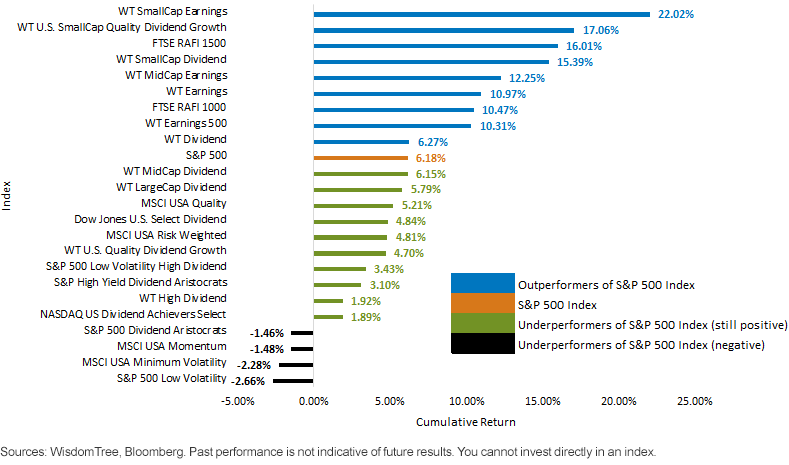Smart Beta Strategies Stress Test in Second Half of 2016


How Strategies Won as Rates Rose
• Small Caps: One aspect of small-cap companies is their ability to respond quickly to trends of improving growth, which is typically apparent during periods when the 10-Year yield is increasing. Additionally, they tend to have cyclical exposures regarding sectors instead of more defensive exposures. Also, if the U.S. dollar is strengthening (not unusual when the 10-Year yield is rising), these firms do not tend to have exports as their dominant source of revenue and therefore have less of a competitive headwind.
• Earnings: Rising rates tend to place strategies with higher valuations at risk, because one impact of rising rates is to lower the current valuation multiple of equities. WisdomTree’s earnings strategies are designed to provide lower price-to-earnings (P/E) ratio exposures to the market segments upon which they focus. It’s also notable that they tend to naturally be under-weight in the more defensive sectors of the market (Utilities and Telecommunication Services are two big examples) that usually tended to do better during the falling rate periods that directly preceded the rising rate period.
• Low Volatility/Minimum Volatility: It’s important to realize that the word “volatility” relates to both upside and downside market movements, seeking to lower both of them. Typically, this leads to very defensively oriented sector positioning, which can be problematic if the rising rate period is directly preceded by a significant fall in interest rates. Why? Well, this market movement can bid up the valuation of these more “falling rate”-oriented sectors. If the interest rate inflection point occurs quickly, these sectors may correct quickly, because they may have become among the most expensive in the market at that time.
• Momentum: Typical momentum strategies look at performance over distinct time horizons, tilting exposure to stocks that have performed positively over those horizons. The problem with an interest rate inflection such as the one that occurred in 2016 is that equity leadership can then change quickly, and it takes time for the momentum approach to rebalance and adjust to the change in conditions. In early 2016, there was also a big overlap between momentum indexes and low- volatility indexes in terms of constituents.
Rising Rate Case Study (July 8, 2016 to December 31, 2016) When U.S. 10- Year Treasury Note Interest Rate Went from 1.36% to 2.44%

• Outperformers of the S&P 500 Index: Because this is the most widely followed measure of U.S. equity performance on earth, it’s one question often asked even of strategies that don’t have a large-cap focus. In total, nine indexes shown here outperformed the S&P 500 Index over this period, and four were directly focused on small caps—not just any four, but the best-performing four. The WisdomTree SmallCap Earnings Index was the best, and it had the smallest-weighted average market capitalization along with a very cyclical sector positioning.
• Underperformers of the S&P 500 Index That Were Still Positive: Over this period, many dividend-focused strategies had positive returns but lagged the market with their tilt to more defensive and interest rate-sensitive sectors.
• Underperformers of the S&P 500 Index That Delivered Negative Returns: Four indexes wound up in this grouping, two of which focused on low-volatility strategies, one on high-dividend stocks, and one on momentum (which overlapped with minimum volatility from those stocks’ momentum in the first half of the year).
Smart beta indexes are gaining popularity. One of the constant refrains in due diligence is that one must know the factor exposures and how they perform in various market environments. The interest rate cycle in the last six months of the year provided a critical stress test for how various indexes have performed in different environments. If you view interest rates as potentially rising further in 2017, we believe it would definitely pay to study this period and the various moves in factor-oriented strategies.
1Sources: WisdomTree, Bloomberg.
2Sources: WisdomTree, Bloomberg.
Important Risks Related to this Article
Double-digit returns were achieved primarily during favorable market conditions. Investors should not expect that such favorable returns can be consistently achieved.
Christopher Gannatti began at WisdomTree as a Research Analyst in December 2010, working directly with Jeremy Schwartz, CFA®, Director of Research. In January of 2014, he was promoted to Associate Director of Research where he was responsible to lead different groups of analysts and strategists within the broader Research team at WisdomTree. In February of 2018, Christopher was promoted to Head of Research, Europe, where he was based out of WisdomTree’s London office and was responsible for the full WisdomTree research effort within the European market, as well as supporting the UCITs platform globally. In November 2021, Christopher was promoted to Global Head of Research, now responsible for numerous communications on investment strategy globally, particularly in the thematic equity space. Christopher came to WisdomTree from Lord Abbett, where he worked for four and a half years as a Regional Consultant. He received his MBA in Quantitative Finance, Accounting, and Economics from NYU’s Stern School of Business in 2010, and he received his bachelor’s degree from Colgate University in Economics in 2006. Christopher is a holder of the Chartered Financial Analyst Designation.

